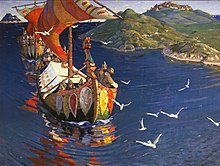Tribal society

The tribal society is a social structure and political form of organization that appeared very early in human history and is still present and effective in some cultural areas today. It is considered by some authors to be the simplest form of a ranking society in which power is bestowed by the community on capable leaders. Other authors see them as a special form of domination-free ( acephalous ) societies.
Based on the knowledge that farmers or pastoral nomads of modern times organized themselves mainly into tribes (the best known are the Indian tribes of North America ), it is assumed that the peoples of the Neolithic cultures were organized in the same way. It is known, for example, from the early Greeks and Italians ( gentile organization of the Greeks and Romans in tribes ). Many ethnic groups in Central Asia or America are still tribal societies today (within modern nation states).
Ancestry Myths and Historical Evidence
Tribal society often includes a myth about the origin of the tribe, a gentilian tribal organization, a puberty and tribal initiation , a tribal law developed and changing through the judiciary, a politically directly decisive gathering of tribal members and the contingent of tribal warriors. The tribal society regards itself as the descendants of a divine progenitor and therefore as a single large "family". Their ethnic religions are originally animistic (everything is "animated") or polytheistic (many gods) and in many cases include the worship of ancestors ( ancestor cult ).
A well-known example of a tribal society is the people of the Israelites , who, according to the tales of the Tanach , knew that they were connected in pre-state times through their common descent from the archparents , their tribal god ( YHWH ) and his traditional law ( covenant book ) and a division into tribes (the twelve tribes of Israel ) and clans. Such a system also existed among the ancient Greeks , Romans , Teutons and in many areas in ancient times. The comparability of two passages from Homer's Iliad and the Germania of Tacitus is seen as evidence of a system that was widespread at the time . In the Iliad , Nestor advises Agamemnon: “Raise the army to Phylen and Phratrien , Agamemnon; so the phyle can assist the phyle, and the phratry the phratry. If you act accordingly and the Achaeans follow you, you will soon recognize which of the leaders and teams is cowardly or also efficient - they fight in the circle of their own ”(2nd Canto, verse 362). Tacitus writes the same about the Germanic peoples: "They especially encourage bravery that it is not chance and arbitrary combination, but families and sexes that form the cavalry or battle wedge".
The ranking society

The term "rank society", coined by the American ethnologist Morton Fried in the 1960s, unites tribal societies and chiefdoms . In contrast to the rulerless (acephalous) societies, according to Fried, leadership is accepted by one (or more) people. In most cases, these leaders are called " chief called" (English chief ). However, there are clear differences between chiefs of tribes and chiefs: tribal chiefs must have distinguished themselves through special skills; particularly talented hunters became “hunting chiefs”, strategists “war chiefs”, others “peace chiefs”. It also follows from this that the authority of the tribal chiefs was given and that they often only exercised their office temporarily - in contrast to chiefdoms. Tribal chiefs hardly had any real powers.
In rank societies there are no social class differences that are characterized by different access to resources. There is therefore no ruling elite that has exclusive control over the means of production and can exercise political coercion. A well-known example of a historical ranking society is the early medieval Merovingian Empire , in which the medieval class structure had not yet developed.
See also
- Tribal association (a confederation)
- Tribal society in historical materialism · tribalism (tribalism)
- Phyle (Greek: tribe) Gens (Roman: clan)
- Horde
- Lineage (ancestry group) Clan (mythical ancestry group)
- Ethnogenesis
literature
- Stefan Breuer : On the sociogenesis of the patrimonial state. In: Stefan Breuer, Hubertreiber : The emergence and structural change of the state (= contributions to social science research. Volume 38). Westdeutscher Verlag, Opladen 1982, ISBN 3-531-11609-6 , pp. 163-227.
- S. Humphreys: Anthropology and the Greeks. London 1978, Chapter 8.
- Adam Kuper: The Invention of the Primitive Society. Transformation of an Illusion. Routledge, London 1988 (English).
Individual evidence
- ↑ Dieter Steiner : Stages of the transformation from egalitarian to stately societies. In: Social in the narrower sense. Own website, Zurich, 1998, accessed on October 27, 2019 (emeritus professor for human ecology ).
- ^ Dieter Haller : Dtv-Atlas Ethnologie. 2nd, completely revised and corrected edition. dtv, Munich 2010, ISBN 978-3-423-03259-9 , pp. 165–167 and 196/197.
- ^ Tacitus : Germania . K. 7.
- ↑ Walter Hirschberg (Ed.): Dictionary of Ethnology. New edition, 2nd edition. Reimer, Berlin 2005, ISBN 3-496-02650-2 , pp. 161 and 304.
- ^ Dieter Haller : Dtv-Atlas Ethnologie. 2nd, completely revised and corrected edition. dtv, Munich 2010, ISBN 978-3-423-03259-9 , p. 196.
- ↑ Dieter Steiner : Political Aspects of Tribal Societies. In: Social in the narrower sense. Own website, Zurich, 1998, accessed on October 27, 2019 .
- ↑ Heiko Steuer : Noble graves, court burial and grave robbery. In: Ulrich Nuber (ed.): The southwest in the 8th century from a historical and archaeological point of view. Thorbecke, Ostfildern 2004, ISBN 3-7995-7363-1 , pp. 193–217, here p. 211 ( special print: PDF, 530 kB, 26 pages on uni-freiburg.de ).